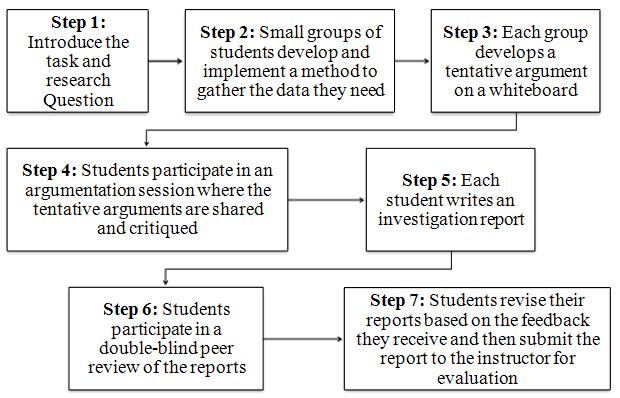Argument-Driven Inquiry
Argument-Driven Inquiry

Figure 1: Seven steps to Argument Driven Inquiry
1
The question. Each lab investigation will focus on answering a research question.
2
Investigation and Data collection. For each investigation students will have a list of materials and some general suggestions for how to start collecting data, but there are no detailed instructions to follow. It is up to each group of students to decide what to do and to coordinate their efforts so that everyone is involved. During this stage of the model, the goal of the lab instructor is to support students as they work instead of telling them what to do.
3
Creation of Posters. Each group will produce a poster presenting their explanation or answer to the research question along with their evidence and reasoning. This is not a detailed presentation of data, but a presentation of an argument, which is a conclusion, supported with evidence and a rationale that explains why the evidence supports the conclusion.
4
Argumentation session. Each group will leave one member at the table to present their argument and the remaining group members will move around the room to other groups. At each table the presenter will begin a discussion of the results with the visiting group. The students should compare results and question each other's findings and method.
5
Creation of an investigation report. The investigation report consists of three sections identified by the following questions.
- Section 1: What were you trying to explain (or figure out) and why?
- Section 2: How did you go about your work and why did you conduct your investigation in this way?
- Section 3: What is your argument?
A scoring rubric is used to assign points for each section of the lab report. Students should refer to this rubric as they write their report. Specific concepts that should be addressed in each of the three sections of the report are provided on the investigation handout.
6
Double Blind Peer Review. Each student will bring four copies of their investigation report to lab. The report will be labeled with an assigned number, NOT the student's name. There are four copies for each member of the reviewing team. The reviewing team will read the investigation report and collaborate in completing a peer review sheet. Reviewers should identify deficiencies in the lab report and make suggestions for improvement on the peer review sheet. All comments and corrections should also be consolidated onto one copy of the investigation report. Before each peer review session the instructor will highlight key concepts that should be addressed in each of the three sections of the report.
7
Revision and submission of the investigation report. If a student's investigation report is accepted by the reviewing team they may submit it "as is" to the instructor. Most students choose to revise their investigation report based on the peer review suggestions and insight gained by reading other lab reports. The instructor will collect revised investigation reports, along with the peer review sheet and the marked-up copy of the original investigation report the following week. The instructor will then score the investigation report using the scoring rubric. The instructor will also check the peer review to see if the reviewers noted deficiencies that were not addressed in the revision.
